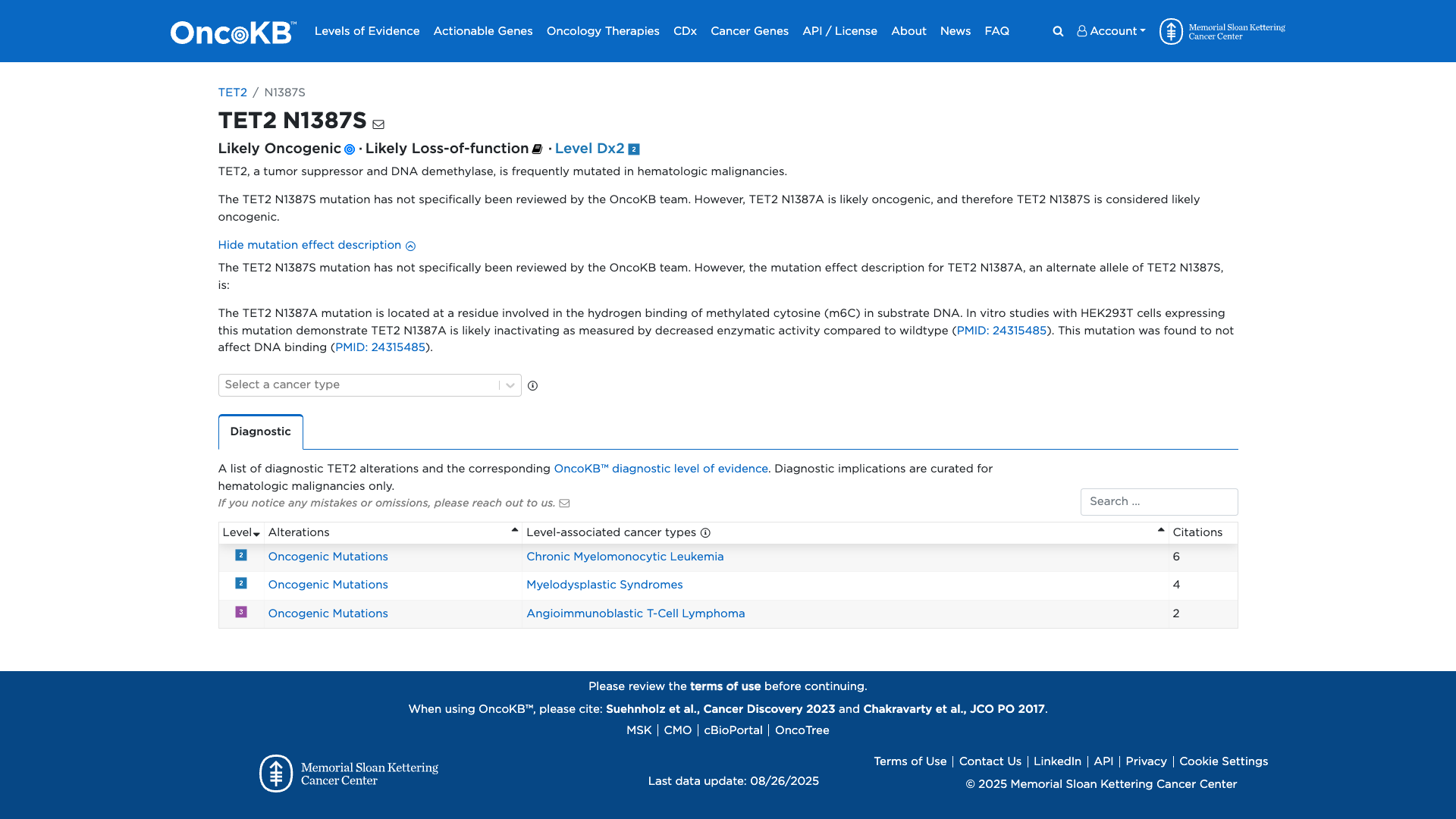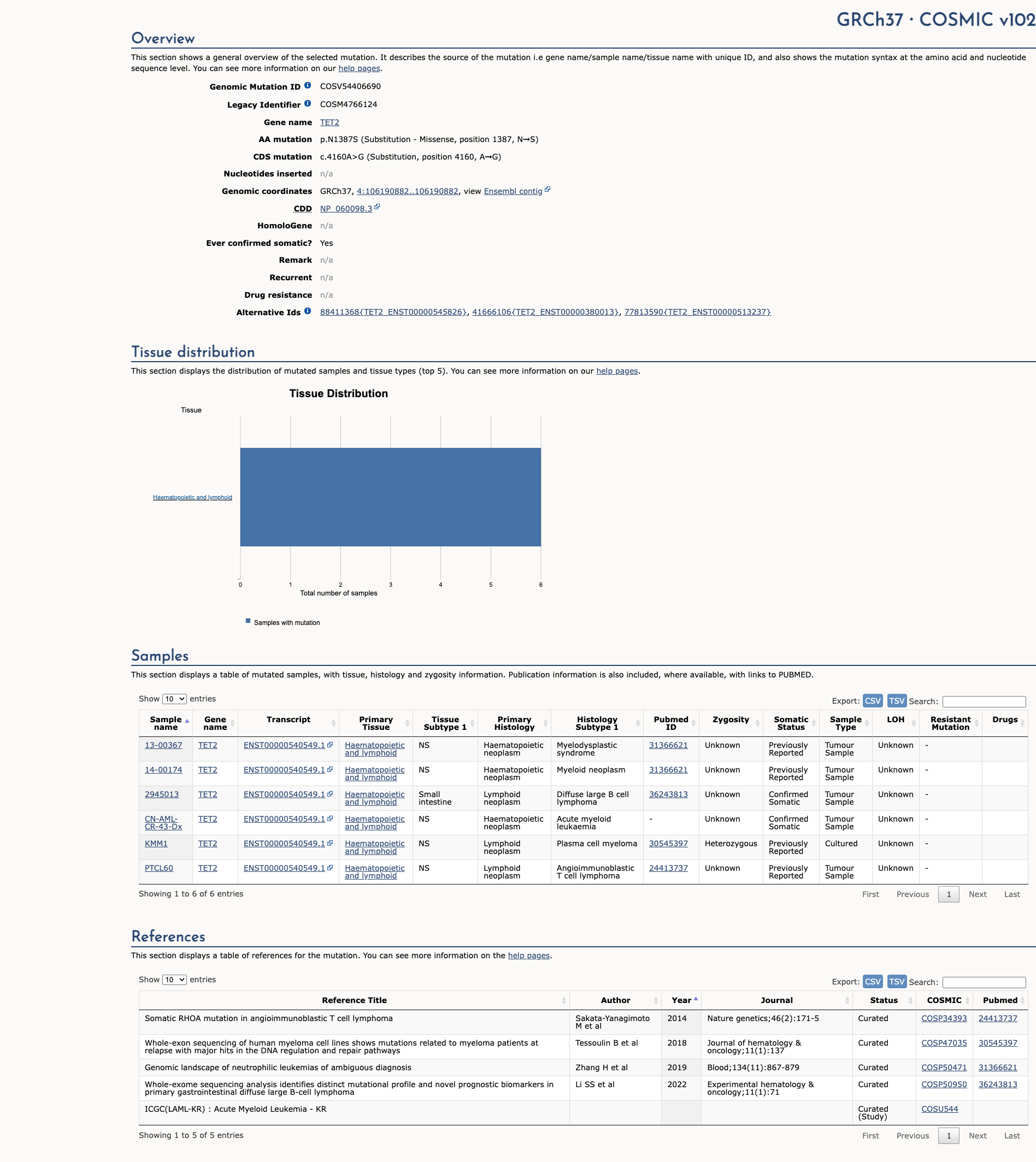TET2 c.4160A>G, p.Asn1387Ser
NM_001127208.2:c.4160A>G
COSMIC ID: COSM4766124
Variant of Uncertain Significance (VUS)
The TET2 N1387S variant remains classified as Variant of Uncertain Significance (VUS). Two moderate pathogenic criteria (PM2, PM5) are offset by two supporting benign criteria (BP1, BP4), with no additional strong or very strong evidence to allow reclassification.
ACMG/AMP Criteria Applied
PM2
PM5
BP1
BP4
Genetic Information
Gene & Transcript Details
Gene
TET2
Transcript
NM_001127208.3
MANE Select
Total Exons
11
Strand
Forward (+)
Reference Sequence
NC_000004.11
Alternative Transcripts
| ID | Status | Details |
|---|---|---|
| NM_001127208.1 | Alternative | 11 exons | Forward |
| NM_001127208.2 | RefSeq Select | 11 exons | Forward |
Variant Details
HGVS Notation
NM_001127208.2:c.4160A>G
Protein Change
N1387S
Location
Exon 9
(Exon 9 of 11)
5'Exon Structure (11 total)3'
Functional Consequence
Loss of Function
Related Variants
No evidence of other pathogenic variants at position 1387 in gene TET2
Alternate Identifiers
COSM4766124
Variant interpretation based on transcript NM_001127208.3
Genome Browser
Loading genome browser...
HGVS InputNM_001127208:c.4160A>G
Active Tracks
ConservationRefSeqClinVargnomAD
Navigation tips: Use mouse to drag and zoom. Click on features for details.
Clinical Data
Global Frequency
0.00064%
Very Rare
Highest in Population
European (non-Finnish)
0.00166%
Rare
Global: 0.00064%
European (non-Finnish): 0.00166%
0%
0.05%
0.1%
1%
5%
10%+
Allele Information
Total: 156238Alt: 1Homozygotes: 0
ACMG Criteria Applied
PM2
This variant is present in gnomAD (MAF= 0.00064%, 1/156238 alleles, homozygotes = 0) and at a higher frequency in the European (non-Finnish) population (MAF= 0.00166%, 1/60220 alleles, homozygotes = 0). The variant is rare (MAF < 0.1%), supporting PM2 criterion application.
Classification
Uncertain Significance (VUS)
Based on 1 submitter review in ClinVar
Submitter Breakdown
1 VUS
Pathogenic
Likely Path.
VUS
Likely Benign
Benign
Publications (0)
No publication details.
Clinical Statement
This variant has been reported in ClinVar as Uncertain significance (1 clinical laboratories).
Functional Impact
Functional Domain
Hotspot Status
Not a hotspot
Domain Summary
This variant is not located in a mutational hotspot or critical domain (0 mutations).
Related Variants in This Domain
No evidence of other pathogenic variants at position 1387 in gene TET2
Functional Summary
The TET2 N1387S variant has not been directly functionally characterized. However, the TET2 N1387A variant, which affects the same residue, has been shown to result in decreased enzymatic activity without affecting DNA binding, suggesting a likely inactivating effect. This implies that TET2 N1387S may also have a similar damaging effect, but direct functional evidence for TET2 N1387S is not available.
Database Previews
OncoKB

JAX-CKB

Click on previews to view full database entries. External databases may require institutional access.
Computational Analysis
Pathogenicity Predictions
REVEL Score
0.405
0.405
Likely Benign0.0
Uncertain (Low)0.2
Uncertain (Med)0.5
Likely Pathogenic0.75
REVEL scores ≥ 0.75 are strong evidence (PP3)
Predictor Consensus
Mixed/VUS
PP3 Applied
No
Additional Predictors
Benign:
CADD: 4.46
VCEP Guidelines
Applied ACMG/AMP Criteria (VCEP Specific)
PVS1
PVS1 (Not Applied) Strength Modified
According to standard ACMG guidelines, the rule for PVS1 is: "Null variant in a gene where loss of function (LoF) is a known mechanism of disease". The evidence for this variant shows: it is a missense change, not a null variant. Therefore, this criterion is not applied because the variant is not a null variant.
PS1
PS1 (Not Applied) Strength Modified
According to standard ACMG guidelines, the rule for PS1 is: "Same amino acid change as a known pathogenic variant but different nucleotide change". The evidence for this variant shows: no previously established pathogenic variant results in the same amino acid change (N1387S). Therefore, this criterion is not applied because there is no identical amino acid change in a known pathogenic variant.
PS2
PS2 (Not Applied) Strength Modified
According to standard ACMG guidelines, the rule for PS2 is: "De novo (both maternity and paternity confirmed) in a patient with the disease and no family history". The evidence for this variant shows: no information on de novo status or parental testing. Therefore, this criterion is not applied because data on de novo occurrence with parental confirmation are lacking.
PS3
PS3 (Not Applied) Strength Modified
According to standard ACMG guidelines, the rule for PS3 is: "Well-established functional studies supportive of a damaging effect on the gene or gene product". The evidence for this variant shows: no direct functional studies for N1387S; only indirect inference from a different substitution at the same residue. Therefore, this criterion is not applied because direct, well-established functional data are not available.
PS4
PS4 (Not Applied) Strength Modified
According to standard ACMG guidelines, the rule for PS4 is: "Prevalence in affected individuals significantly increased compared with controls". The evidence for this variant shows: no case-control or prevalence data in affected individuals. Therefore, this criterion is not applied because comparative prevalence data are missing.
PM1
PM1 (Not Applied) Strength Modified
According to standard ACMG guidelines, the rule for PM1 is: "Located in a mutational hot spot or well-established functional domain without benign variation". The evidence for this variant shows: no data indicating that residue N1387 is a mutational hotspot or part of a critical functional domain. Therefore, this criterion is not applied.
PM2
PM2 (Moderate)
According to standard ACMG guidelines, the rule for PM2 is: "Absent from controls (or at extremely low frequency if recessive)". The evidence for this variant shows: extremely rare in population databases (gnomAD MAF = 0.00064%, no homozygotes). Therefore, this criterion is applied at Moderate strength because the variant is absent or at extremely low frequency in controls.
PM3
PM3 (Not Applied) Strength Modified
According to standard ACMG guidelines, the rule for PM3 is: "Detected in trans with a pathogenic variant (for recessive disorders)". The evidence for this variant shows: no information on trans configuration with another pathogenic variant and TET2-associated disorders are not strictly recessive. Therefore, this criterion is not applied.
PM4
PM4 (Not Applied) Strength Modified
According to standard ACMG guidelines, the rule for PM4 is: "Protein length changes due to in-frame deletions/insertions or stop-loss variants". The evidence for this variant shows: no change in protein length (missense). Therefore, this criterion is not applied.
PM5
PM5 (Moderate)
According to standard ACMG guidelines, the rule for PM5 is: "Novel missense change at an amino acid residue where a different pathogenic missense change has been seen". The evidence for this variant shows: a different missense substitution at residue N1387 (N1387A) has been functionally characterized with decreased enzymatic activity, consistent with pathogenicity. Therefore, this criterion is applied at Moderate strength because another missense change at the same residue is likely pathogenic.
PM6
PM6 (Not Applied) Strength Modified
According to standard ACMG guidelines, the rule for PM6 is: "Assumed de novo, but without confirmation of paternity and maternity". The evidence for this variant shows: no de novo assumption data. Therefore, this criterion is not applied.
PP1
PP1 (Not Applied) Strength Modified
According to standard ACMG guidelines, the rule for PP1 is: "Co-segregation with disease in multiple affected family members". The evidence for this variant shows: no family segregation data. Therefore, this criterion is not applied.
PP2
PP2 (Not Applied) Strength Modified
According to standard ACMG guidelines, the rule for PP2 is: "Missense variant in a gene with a low rate of benign missense variation and where missense variants are a common mechanism of disease". The evidence for this variant shows: TET2 disease mechanism is predominantly loss-of-function, not missense. Therefore, this criterion is not applied.
PP3
PP3 (Not Applied) Strength Modified
According to standard ACMG guidelines, the rule for PP3 is: "Multiple lines of computational evidence support a deleterious effect on the gene/gene product". The evidence for this variant shows: mixed in silico results (CADD benign, REVEL below threshold) and SpliceAI predicts no splicing impact. Therefore, this criterion is not applied due to lack of consistent computational evidence for deleterious effect.
PP4
PP4 (Not Applied) Strength Modified
According to standard ACMG guidelines, the rule for PP4 is: "Patient's phenotype or family history highly specific for a disease with a single genetic etiology". The evidence for this variant shows: no phenotype or clinical context provided. Therefore, this criterion is not applied.
PP5
PP5 (Not Applied) Strength Modified
According to standard ACMG guidelines, the rule for PP5 is: "Reputable source reports variant as pathogenic, but without accessible evidence". The evidence for this variant shows: ClinVar reports uncertain significance only. Therefore, this criterion is not applied.
BA1
BA1 (Not Applied) Strength Modified
According to standard ACMG guidelines, the rule for BA1 is: "Allele frequency is too high for the disorder (based on population data)". The evidence for this variant shows: allele frequency is extremely low (MAF 0.00064%). Therefore, this criterion is not applied.
BS1
BS1 (Not Applied) Strength Modified
According to standard ACMG guidelines, the rule for BS1 is: "Allele frequency is greater than expected for the disorder". The evidence for this variant shows: allele frequency is well below thresholds for TET2-related disorders. Therefore, this criterion is not applied.
BS2
BS2 (Not Applied) Strength Modified
According to standard ACMG guidelines, the rule for BS2 is: "Observed in a healthy adult individual for a dominant (with full penetrance expected at an early age), X-linked or mitochondrial disorder with full penetrance expected at an early age". The evidence for this variant shows: no data on healthy adult observations. Therefore, this criterion is not applied.
BS3
BS3 (Not Applied) Strength Modified
According to standard ACMG guidelines, the rule for BS3 is: "Well-established functional studies show no damaging effect on protein function or splicing". The evidence for this variant shows: no direct functional studies demonstrating lack of effect. Therefore, this criterion is not applied.
BS4
BS4 (Not Applied) Strength Modified
According to standard ACMG guidelines, the rule for BS4 is: "Lack of segregation in affected family members". The evidence for this variant shows: no segregation data. Therefore, this criterion is not applied.
BP1
BP1 (Supporting)
According to standard ACMG guidelines, the rule for BP1 is: "Missense variant in a gene where only LoF causes disease". The evidence for this variant shows: TET2 disease mechanism is loss-of-function and this is a missense change. Therefore, this criterion is applied at Supporting strength.
BP2
BP2 (Not Applied) Strength Modified
According to standard ACMG guidelines, the rule for BP2 is: "Observed in trans with a pathogenic variant for dominant disorders or in cis with a pathogenic variant". The evidence for this variant shows: no reports of co-occurrence with other pathogenic variants. Therefore, this criterion is not applied.
BP3
BP3 (Not Applied) Strength Modified
According to standard ACMG guidelines, the rule for BP3 is: "In-frame deletions/insertions in a repetitive region without known function". The evidence for this variant shows: it is a missense SNV, not an in-frame indel. Therefore, this criterion is not applied.
BP4
BP4 (Supporting)
According to standard ACMG guidelines, the rule for BP4 is: "Multiple lines of computational evidence suggest no impact". The evidence for this variant shows: mixed in silico predictors with benign CADD and low REVEL, and SpliceAI predicts no splicing impact. Therefore, this criterion is applied at Supporting strength.
BP5
BP5 (Not Applied) Strength Modified
According to standard ACMG guidelines, the rule for BP5 is: "Variant found in a case with an alternate molecular basis for disease". The evidence for this variant shows: no such case data. Therefore, this criterion is not applied.
BP6
BP6 (Not Applied) Strength Modified
According to standard ACMG guidelines, the rule for BP6 is: "Reputable source reports variant as benign, but without accessible evidence". The evidence for this variant shows: no reputable source reporting benign. Therefore, this criterion is not applied.
BP7
BP7 (Not Applied) Strength Modified
According to standard ACMG guidelines, the rule for BP7 is: "Synonymous variant with no predicted impact on splicing". The evidence for this variant shows: it is a missense change, not synonymous. Therefore, this criterion is not applied.

